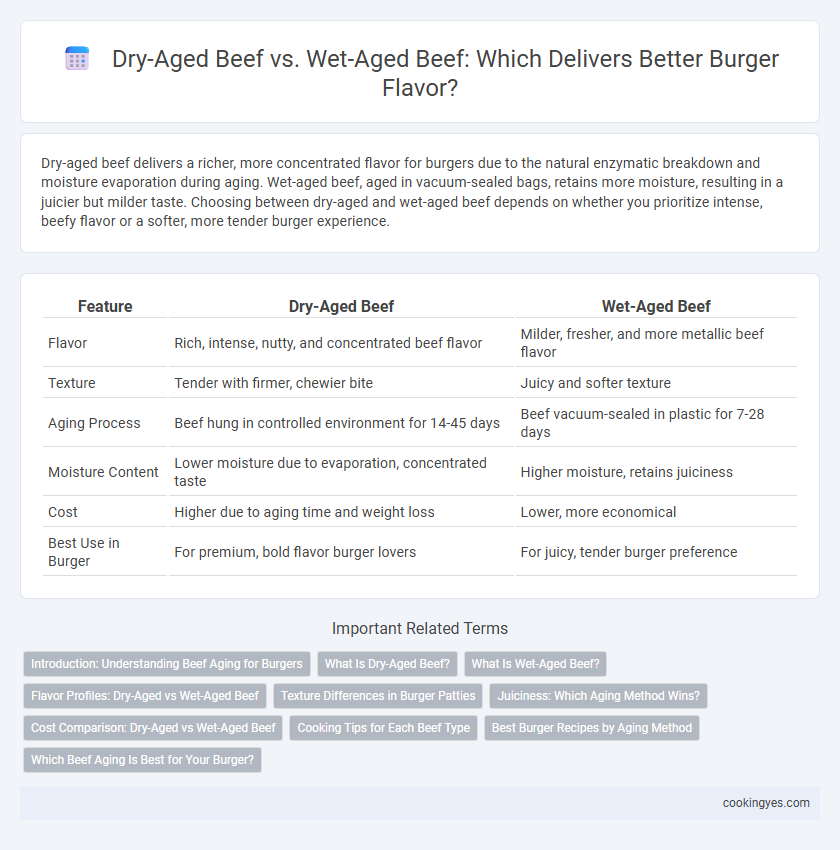Dry-aged beef delivers a richer, more concentrated flavor for burgers due to the natural enzymatic breakdown and moisture evaporation during aging. Wet-aged beef, aged in vacuum-sealed bags, retains more moisture, resulting in a juicier but milder taste. Choosing between dry-aged and wet-aged beef depends on whether you prioritize intense, beefy flavor or a softer, more tender burger experience.
Table of Comparison
| Feature | Dry-Aged Beef | Wet-Aged Beef |
|---|---|---|
| Flavor | Rich, intense, nutty, and concentrated beef flavor | Milder, fresher, and more metallic beef flavor |
| Texture | Tender with firmer, chewier bite | Juicy and softer texture |
| Aging Process | Beef hung in controlled environment for 14-45 days | Beef vacuum-sealed in plastic for 7-28 days |
| Moisture Content | Lower moisture due to evaporation, concentrated taste | Higher moisture, retains juiciness |
| Cost | Higher due to aging time and weight loss | Lower, more economical |
| Best Use in Burger | For premium, bold flavor burger lovers | For juicy, tender burger preference |
Introduction: Understanding Beef Aging for Burgers
Dry-aged beef develops a rich, intense flavor and tender texture through controlled oxygen exposure and moisture evaporation over several weeks, enhancing the burger's taste complexity. Wet-aged beef, aged in vacuum-sealed packaging, retains more moisture, resulting in a juicier but less concentrated flavor profile ideal for flavorful, succulent burgers. Understanding these aging methods allows burger enthusiasts to choose between bold, savory notes or a moist, tender bite tailored to their taste preference.
What Is Dry-Aged Beef?
Dry-aged beef is a premium aging process where whole primal cuts are hung in a controlled, refrigerated environment for several weeks, allowing natural enzymes to break down muscle tissue and intensify flavor. This method results in a distinct, concentrated beefy taste with enhanced tenderness and a firmer texture, ideal for gourmet burgers. Compared to wet-aged beef, which is vacuum-sealed in plastic to retain moisture, dry-aging produces a unique umami profile and a crispy, caramelized crust when cooked.
What Is Wet-Aged Beef?
Wet-aged beef is beef that has been vacuum-sealed in plastic and stored under refrigeration for several days to weeks, allowing natural enzymes to break down muscle fibers and enhance tenderness. This method retains moisture, resulting in a juicier texture and a milder, slightly metallic flavor compared to dry-aged beef. Wet-aged beef is commonly used in burgers for its cost-effectiveness and consistent, fresh taste.
Flavor Profiles: Dry-Aged vs Wet-Aged Beef
Dry-aged beef for burgers develops a deep, concentrated flavor with nutty, earthy, and slightly funky notes due to moisture evaporation and enzymatic breakdown during aging. Wet-aged beef retains more moisture, resulting in a juicier texture with a milder, more metallic, and slightly bloody flavor. The flavor intensity in dry-aged beef enhances umami richness, while wet-aged beef offers a fresher, cleaner taste benefiting from its sealed, vacuum-packed aging process.
Texture Differences in Burger Patties
Dry-aged beef offers a firmer, denser texture with concentrated, nutty flavors due to moisture loss during aging, enhancing burger patties with a robust chew. Wet-aged beef retains more moisture, resulting in a juicier, softer patty that emphasizes a milder, fresher beef taste. The texture contrast influences the burger experience significantly, with dry-aged providing a hearty bite and wet-aged delivering tenderness.
Juiciness: Which Aging Method Wins?
Dry-aged beef delivers a more intense, concentrated flavor with a firmer texture, while wet-aged beef retains higher moisture content, resulting in superior juiciness for burgers. The vacuum-sealed wet-aging process preserves the natural juices, making wet-aged beef the preferred choice when juiciness is the top priority. However, dry-aging enhances umami and complexity, offering a rich taste experience that may compensate for slightly reduced moisture levels.
Cost Comparison: Dry-Aged vs Wet-Aged Beef
Dry-aged beef commands a higher price due to prolonged storage and moisture loss, which enhances flavor complexity but increases cost per pound for burger patties. Wet-aged beef, stored in vacuum-sealed packaging, retains more moisture and is more affordable with a shorter aging period, making it cost-effective for bulk burger production. Choosing between dry-aged and wet-aged beef balances flavor enrichment against budget constraints in burger preparation.
Cooking Tips for Each Beef Type
Dry-aged beef for burgers offers a concentrated, nutty flavor and firmer texture, suitable for high-heat cooking methods like grilling or broiling to enhance its savory crust without overcooking the interior. Wet-aged beef retains more moisture, creating a juicier patty best cooked over medium heat on a stovetop or griddle to maintain tenderness and avoid excessive shrinkage. To maximize flavor, dry-aged burgers benefit from minimal seasoning to preserve unique taste notes, while wet-aged patties handle robust seasoning blends and toppings that complement their milder profile.
Best Burger Recipes by Aging Method
Dry-aged beef enhances burger flavor by concentrating natural umami and imparting a nutty, complex taste through moisture evaporation during aging. Wet-aged beef retains juiciness and tenderness, offering a milder flavor profile ideal for preserving beef's freshness in burger recipes. The best burger recipes tailor seasoning and cooking techniques to each aging method, maximizing dry-aged beef's depth or wet-aged beef's moisture for optimal taste and texture.
Which Beef Aging Is Best for Your Burger?
Dry-aged beef offers a more intense, nutty, and concentrated flavor with a firmer texture, making it ideal for gourmet burgers seeking robust taste. Wet-aged beef retains more moisture and delivers a milder, juicier profile, making it suitable for traditional burgers where tenderness and succulence are prioritized. Choosing the best beef aging method depends on whether you prefer a bold, complex flavor or a tender, juicy bite in your burger.
Dry-aged beef vs wet-aged beef for burger flavor Infographic

 cookingyes.com
cookingyes.com